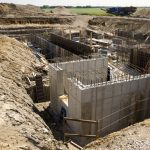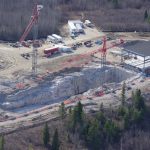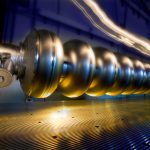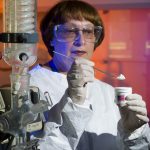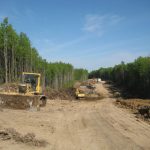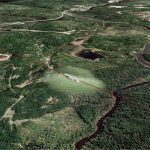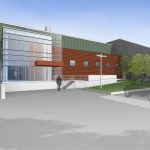Funds are part of more than $327 million in new Recovery Act funding to be disbursed by Department of Energy’s Office of Science
Batavia, Ill. – In the latest installment of funding from the U.S. Department of Energy’s Office of Science under the American Recovery and Reinvestment Act, DOE’s Fermi National Accelerator Laboratory will receive an additional $60.2 million to support research toward next generation particle accelerators and preliminary design for a future neutrino experiment.
The new funds are part of more than $327 million announced by Energy Secretary Steven Chu on Tuesday from funding allocated under the Recovery Act to DOE’s Office of Science. Of these funds, $220 million will go toward scientific research, instrumentation and laboratory infrastructure projects at DOE national laboratories.
“The new initiatives will help the U.S. maintain its scientific leadership and economic competitiveness while creating new jobs,” said Energy Secretary Steven Chu. “The projects provide vital funding and new tools for research aimed at strengthening America’s energy security and tackling some of science’s toughest challenges.”
Taking the stimulus funds announced earlier this year into account, the Recovery Act provides more than $100 million in funding to Fermilab.
Fermilab is investing the funds in critical scientific infrastructure to strengthen the nation’s global scientific leadership as well as to provide immediate economic relief to local communities. Out of the additional $60.2 million, the laboratory will devote $52.7 million to research on next-generation accelerators using superconducting radio frequency technology. This technology provides a highly efficient way to accelerate beams of particles with potential applications in medicine, energy and material science. Fermilab will use the remaining $7.5 million for preliminary design for a future neutrino experiment.
With this final round of projects, the Obama Administration has now approved projects covering the full $1.6 billion that the DOE Office of Science received from Congress under the Recovery Act.
“The Recovery Act funding will put our neighbors and fellow Americans to work,” said Fermilab Director Pier Oddone. “We are investing the funds in local firms and other U.S. companies who will be our partners in strengthening the nation’s scientific leadership.”
More information about Fermilab and the American Recovery and Reinvestment Act is available at http://www.fnal.gov/recovery/
DOE’s news release is available at http://www.energy.gov/news2009/7737.htm
- The steel shell for the addition to Industrial Building 3 marks the future location of Fermilab’s new materials laboratory space. The American Recovery and Reinvestment Act is providing $4.9 million for the project, including approximately $3 million to cover initial construction costs. The remaining budget will fund furnishings and several building upgrades, as well as construction management and a budgeted reserve to account for unplanned costs.
- Fermilab has awarded to R.C. Wegman Construction Co. a $3.5-million contract for the expansion of the MI-8 building. The construction project, funded by the American Recovery and Reinvestment Act, is giving a boost to local companies and will provide much-needed space to the technicians who support Fermilab’s neutrino program.
- Construction crews are altering the existing New Muon Building to make the facility capable of producing and testing key components for superconducting radio frequency technology. They are building an underground enclosure and support housings. Technical beamline equipment will occupy the length of the existing facility and the 202-foot extension. The project will also include work inside the existing building to relocate the loading dock to accommodate the new tunnel enclosure.
- In April, crews finished blasting a hole measuring about 50 by 70 by 350 feet in the granite at the site of the NOvA detector facility in Ash River, Minn. They recently completed the roof of the service building for the NOvA experiment and began pouring the concrete base for the structure in May. Photo: Dan Traska of Einarson Flying Service
- Fermilab received more than $50 million in American Recovery and Reinvestment Act funds for research and development of superconducting radio frequency technology. The technology will be used to build a test area for components needed for the next-generation particle accelerator. Superconducting radiofrequency technology aims to increase the efficiency of transferring particle energy and the amount of energy, speed and mass the particles can acquire.
- Fermilab will receive more than $50 million in American Recovery and Reinvestment Act funds for superconducting radio frequency technology. Some of those funds will be used to build a test area for next-generation particle accelerator components, such as the 9-cell 1.3 GHz superconducting radio frequency cavity shown here.
- Irina Kubantseva, a technician in FermilabÃs Particle Physics Division, will help test the wavelength shifters in the Fermilab chemistry lab when the first shipment arrives in September. Scientists use the chemicals to change the wavelength of particles of light, called photons, into the required range for the experiment.
- Officials break ground at the entrance to the future site of the NOvA detector facility in Ash River, Minnesota on May 1. Fermilab will receive $14.9 million from the American Recovery and Reinvestment Act for NOvA, a new neutrino experiment that will seek to explore the mystery of how matter came to dominate antimatter in the universe.
- A construction crew began clearing and leveling roads at the NOvA site in Ash River, Minnesota on June 1. Construction of the facility is expected to generate 60 to 80 jobs plus purchase of materials and services from U.S. companies. Fermilab will receive $14.9 million American Recovery and Reinvestment Act funds for the NOvA project.
- Jim’s Ash Trail Store in Ash River, Minnesota featured the NOvA Project meal special during the groundbreaking ceremony in May.
- This rendering depicts the future NOvA detector facility on the property in Ash River, Minnesota, about 40 miles southeast of International Falls. Rendering by Holabird & Root
- A rendering of the entrance to the NOvA detector facility. Physicists will use the NOvA experiment to analyze the mysterious behavior of neutrinos sent through the Earth from Fermilab in Illinois to the NOvA detector in Ash River, Minnesota. Rendering by Holabird & Root
- Ash River near the future site of the NOvA detector facility. Photoa; William Miller, NOvA installation manager



